Papers - Opinion Pieces by Pawanexh Kohli
Celerity, 2020
A good supply chain is demand driven; right from provisioning the inputs, to support production, ... more A good supply chain is demand driven; right from provisioning the inputs, to support production, and to distribute the product to final buyer; and the urge to remain competitive drives its optimization. But thanks to the COVID19 pandemic, demand itself is disrupted and will not be the same for years. Hence, when the very basic detail has changed, supply chains will not merely be in need of reengineering but have to be re-designed to the changed status.
In 2015, India's first comprehensive study on its cold-chain capacity was completed. As a result,... more In 2015, India's first comprehensive study on its cold-chain capacity was completed. As a result, past projections of the country requiring another 30 million tons in cold storage capacity were upended. Focus was brought onto other critical infrastructure components that had skipped the attention of development agencies in past decades. This paper reviews the situation nearly 30 months after the public release of this Report and on what next level key steps can be taken.
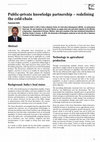
Ag4Dev, 2019
Cold-chain has colloquially been interpreted as cold warehousing, and primarily equated as yet an... more Cold-chain has colloquially been interpreted as cold warehousing, and primarily equated as yet another medium to store surplus agricultural produce, to meet delayed or deferred demand. Whereas this model may be applicable for a small range of perishable produce, the far larger opportunity from cold-chain arises when it is applied as a dynamic integration of a chain of logistics activities, to expand the selling range of perishable produce. This paper discusses these aspects from the Indian perspective, with special focus on fresh horticultural produce. The discussions emphasise the role of cold-chain logistics, and how it serves as an enabler for improving the efficiency of agriculture. The paper explains the untapped opportunity of using cold-chain to connect farm output with wider markets, instead of merely using cold warehousing to build inventory waiting for local demand to resurface.
The ordinances passed in India to ease agricultural trade merely open options, which need to be f... more The ordinances passed in India to ease agricultural trade merely open options, which need to be followed by second order of implementation by development agencies. Without a suitable supply chain orientation towards agricultural development, these market reforms in India will merely end up in incremental changes and not in the desired transformation in the agri-business ecosystem
The battle against Covid-19 will only be won once a vaccine, when developed, is distributed and a... more The battle against Covid-19 will only be won once a vaccine, when developed, is distributed and administered to achieve herd immunity. For that to happen, the cold chain has to be prepared in advance, otherwise the virus will just drag on.
Cold chain has to be looked upon afresh, as a mode that extends the selling range of the produce,... more Cold chain has to be looked upon afresh, as a mode that extends the selling range of the produce, and thus expands the farmers’ market footprint. Efficient agri-logistics enhances market linkage and justifies efforts to produce more and brings overall growth to agriculture
National Conference Agriculture 2022 - Doubling Farmers Income, 2018
Discusses Agri-logistics and cold chain that makes Agricultural activities sustainable and bolste... more Discusses Agri-logistics and cold chain that makes Agricultural activities sustainable and bolsters agricultural incomes. Further, without scope to communicate produce to consumers, food loss cannot be mitigated. Agri-logistics is the backbone of primary agricultural activities, and without able logistics connectivity, there is little scope to double farmers income and efforts to increase productivity come to naught. Conference contribution for apex level discussions on agri-value system, logistics and marketing system to double farmers income by 2022.
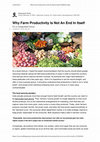
India actually produces more than enough food to feed herself, and the country can claim to be te... more India actually produces more than enough food to feed herself, and the country can claim to be technically food secure. Then, farmers' income growth no longer depends on how much he/she produces, but on the institutional arrangements for marketing, such that they can capture value from every grain, every ounce or every drop produced. Today, when farmers produce a bumper harvest, the prices crash, and when the food prices respond positively to the "demand curve", the consumer affairs department rushes in to make strategic imports to keep prices 'reasonable' for the consumer. Both situations make a dent in farmers' income. Increasingly, we produce more wheat, rice, pulses, cotton and sugar than we can consume or export, global inventories are at an all-time high, and commodity prices are down as never before. Yet, a nutritional deficit is evident and all food is not affordable to all people. Conversely, awareness and demand for nutritional foods such as fresh vegetables, fruits, dairy and meats are fostered by growing affluence. Being perishable, such produce continues to face high losses along to route from farms to markets, detracting from availability and feeding inflationary swings. Markets seem inaccessible and disorganised, with real demand not being suitably communicated or connected with.
International Conference on Cooperatives, 2019
Farming is a business and the business environment defines the value system adopted within the tr... more Farming is a business and the business environment defines the value system adopted within the trade practices in this sector. In various other economic activities across the world, business methods are shifting towards an ecosystem approach. The same discussion needs to prevail in the agricultural sector, so that farmers are not perceived as a weak link in the chain of transactions, but as equal partners, interlinked and intrinsic in the larger business ecosystem.
An article review of the person
Forbes, 2015
Cooling, when deployed with proper purpose, and not just for personal comfort, aids and abets hum... more Cooling, when deployed with proper purpose, and not just for personal comfort, aids and abets human civilization. Without the appropriate cooling application, specifically the cold chain, mankind's progress would be stunted and even crumble.

Farmers need to monetise their produce for optimal value. After Prime Minister Narendra Modi spok... more Farmers need to monetise their produce for optimal value. After Prime Minister Narendra Modi spoke of the national vision to double farmers' income, laying it out as a challenge last year, many have partaken in suggesting strategies, programmes, and resources to achieve this objective. These include policymakers, ex-policymakers, industry councils, students, well-wishers, and most importantly, farmers. A certain consistency is evident among the recommendations that are put forth. The uninitiated profess that a quick and straightforward solution is possible to the complexities of agriculture. Those more rooted in ground level realities, including farmers themselves, will seek coherent tackling of the wide variety of concerns. Usually, the novice will suggest raising subsidies on agricultural inputs, a-la the Chinese model, and raising the government administered support price for certain crops. In effect, they wish that the government subsidise the production, and thereafter purchase the output at a raised cost. This essentially means that agriculture be addressed as a public sector project, and worse, with logic that advocates to further expand the inbuilt inefficiencies. It is ingenuous minds who raise imagery of a perpetual cycle of underpriced inputs and artificially priced outputs; a cycle of fabricated demand and magical reality.
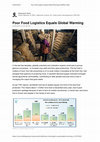
In the last few decades, globally scientists and cultivation experts continued to increase crop y... more In the last few decades, globally scientists and cultivation experts continued to increase crop yield and farm-gate productivity. A resultant demand-supply-mismatch emerged across agricultural commodities, contributing to wide spread food loss and a crisis in managing the output that goes waste. As per FAO reports, worldwide food lost & wasted equals one third of the total food produced. This means about 1.3 billion tons food is discarded every year, due to post production spoilage because of lack of farm-to-market connectivity, in transit loss, and some that is thrown and wasted in the hands of end-users. This quantum of food loss & waste (FLW) is also associated with about 0.5 Gigatons of CO2 equivalent greenhouse gases, which adds to global warming. Unless corrected, these emissions can go up five-fold by 2050, according to a study by Potsdam Institute for Climate Impact Research. While pockets of the globe go hungry, one third of what is produced decomposes into greenhouse gases heating up our atmosphere.
This paper discusses the role of cold chain logistics, and how it serves as an enabler for improv... more This paper discusses the role of cold chain logistics, and how it serves as an enabler for improving the efficiency of agriculture. The discussions emphasise on how trade can be expedited through a delivery oriented cold-chain that dynamically connects with steady state demand across boundaries. The opportunity to connect with existing demand, instead of merely using cold warehousing to build inventory awaiting for local demand to resurface is untapped. This also offers greater opportunity to collaborate among SAARC nations as well to build strategic relationships through cross border trade in food
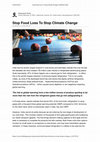
India has the world's largest footprint in cold stores and estimates indicate that over the last ... more India has the world's largest footprint in cold stores and estimates indicate that over the last few decades we have created 130 million cubic metres of refrigerated warehousing space. Quite importantly, 97% of these happen use a natural gas for their refrigeration-in effect, this is the world's largest collection of ammonia-based refrigeration. This is not a petty matter, as most of the developed world has cold stores that deploy artificial refrigerants. Unlike ammonia, these artificial fluids-Hydrochlorofluorocarbons (HCFCs) and Hydrofluorocarbons (HFCs)-either caused ozone depletion or are negatively impacting global warming. The risk to global warming from a few million tonnes of produce spoiling is far more than the risk from the refrigerant gases that go into safeguarding it. In Europe alone, reports indicate that almost 50% of the food chain refrigeration is using gases with a thousand times global warming potential (GWP) compared to CO2. Ammonia on the other hand, which is extensively used in India, has zero GWP. However, India cannot sit pretty because we are entering the next stage of development of our cold-chain. This involves creation of thousands of farm-gate packhouses and multiplying our reefer transport capacity. The first brings decision-making capacity to farm-gate and the latter is necessary to complete the physical link with markets. Both these cold-chain options function for small loads (in comparison to cold stores), and may have intermittent capacity utilization. In these instances, ammonia-based refrigeration is unlikely to be used but the
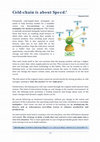
Frequently cold-supply-chain strategists are asked to help develop models for a laudable vision, ... more Frequently cold-supply-chain strategists are asked to help develop models for a laudable vision, one that envisions a revenue multiplier for farmers-producers. This Vision is typically presented alongside tactical options, those that focus on enabling small farmers to offset their sales by storing their weekly or seasonal produce, thus avoiding peak season price drops. This is also expected to avoid distress sales due to low shelf life of the perishable produce. Ergo the cold-store, viewed as a buffer that can extend the trade opportunity, conceivably offering safe, risk free storage and defer the sales transaction to a more favourable future date. This tactic lends itself to the core premise that the buying markets will pay a higher value at a later date, when supply patterns are low. This concept is true to an extent but does not leverage cold chain technology to the fullest. This can be termed as only a delaying tactic, as the transactional partners remain the same. In reality, the market does not change, the buyers remain same, and the location continues to be the local mandi. The full extent of the original vision cannot be served merely by storing produce in cold storages, waiting to 'time the market' for the 'right price'. Furthermore, the buying price will stay routed through the original multi-layered value system. This kind of intervention brings no real change in the market environment! At best, the delaying tactic promotes a trading mind-set and brings about none of the major changes that dynamic supply chains can do. By merely deferring an imminent transaction, without any change to the extent and partners of the transaction, the operating model does not truly contribute as a revenue multiplier-that vision can best be arrived at by reaching out, by multiplying the buyers, and as subsequence providing reason to enhance production and productivity. An intervention must lead to creating a win-win situation, one that will balance demand and supply. The strategy to delay a trade does not convert a zero-sum-game into a win-win situation. This is most applicable in case of high perishable goods where short term storing is not an in-depth solution.











Uploads
Papers - Opinion Pieces by Pawanexh Kohli
The country’s approach towards cold-chain development and the strategy for it, saw some changes over time and some ill-considered omissions and errors towards the end of the last century. Today the country falls short of some critical pieces in the cold-chain for its fresh produce. With this realisation certain re-examination and strategic revisions were attempted in the last decade. The author recounts some of the historical attitudes and policy outlooks that had shaped India’s cold-chain development, and the necessary course corrections that had to be introduced thereafter. The related topical learnings, along with domain specific insights, will provide readers a frame of reference to extract opportune lessons when considering similar developments in other regions of the world. The focus of these chapters is on cold-chain for fresh fruits and vegetables (perishable produce), as the cold-chain for post-mortem products, dairy and healthcare products, through correlated, will be covered separately.